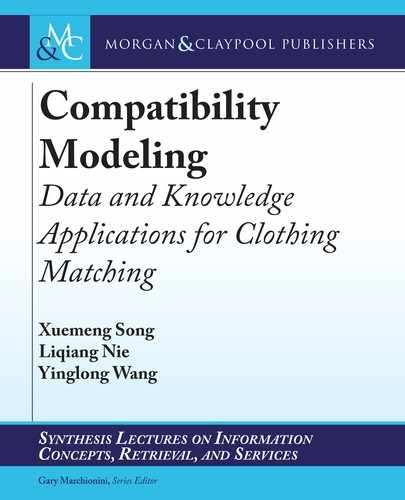
4.4. EXPERIMENT 35
the limited space, Table 4.1 shows several value examples of each attribute.
2
We then calculate
the co-occurrence of the value pairs for each attribute and retain both the top 10 and the last
10 pairs as the rule candidates, as we assume that the high co-occurrence can indicate the high
compatibility and facilitate the screen of positive rules, e.g., “black top goes better with a black
bottom,” while the low co-occurrence may contribute to the derivation of the negative rules,
such as “blouse cannot go with the dress.” e underlying philosophy behind is that sometimes
it is intractable to identify compatible fashion items but effortless to determine the incompati-
ble ones. ereafter, to ensure the quality of these rules extracted from the limited dataset, we
further ask three fashion-lovers to manually screen the rules. Finally, we obtain 15 rules, which
we will be detailed in the following section.
Table 4.1: Value examples of each attribute
Attributes Value Examples
Color Black, white, green, red, blue, grey
Material Knit, silk, leather, cotton, fur, cashmere
Pattern Pure, grid, dot, fl oral, number (letter)
Category Coat, dress, skirt, sweater, jeans, hoodie
Brand Yoins, HM, Topshop, Gucci
For simplicity, we use “value1 + value2” to denote the positive rule, while “no value1 +
value2” representing the negative rule. For example, “black + black” stands for the positive rule
“black tops can go with black bottoms,” and “no silk + knit” represents the negative rule “silk tops
cannot go with knit bottoms.” According to Eq. (4.8), our model needs to determine whether
the pair of t
i
and b
j
activates the given rule. We hence argue that .t
i
; b
j
/ satisfies the (posi-
tive/negative) rule, if the value1 and value2 of the rule, respectively, appear in the contextual
metadata of t
i
and b
j
.
4.4 EXPERIMENT
To evaluate the proposed method, we conducted extensive experiments on the real-world
Dataset I by answering the following research questions.
• Does AKD-DBPR outperform the state-of-the-art methods?
• How do the attention mechanisms affect the performance?
• How does AKD-DBPR perform in the application of the complementary fashion item
retrieval?
2
e complete list can be accessed via https://ilearnfashion.wixsite.com/compatibility-model/.
..................Content has been hidden....................
You can't read the all page of ebook, please click here login for view all page.
